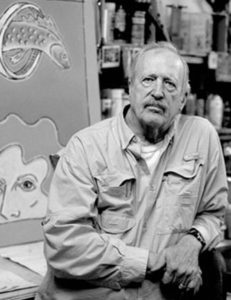
By Joshua Daniel Fisher
A couple weeks ago, I sat down with Paul Harmon in his home studio in Brentwood, Tennessee. The room was well lit with rows of windows and vaulted ceilings. Canvases stacked four or five deep against the walls. We took our seats on two overstuffed sofas in front of a large brick fireplace, facing each other over a tidy coffee table.
You’ve been a prolific artist your entire life, and looking around this room, it’s apparent that you have not eased up at all. What drove you to be an artist in the first place, and what drives you to continue to create new pieces?
My grandmother was an artist. She lived close by and was sort of a neighborhood babysitter for me and my sister growing up. She had a studio in both of the homes that she babysat in, so really, I started out in her studio. She’d be working on the easel and I’d be on my hands and knees working on newsprint. The old joke is that nothing has really changed over the years other than that I got better materials.
She started the Nashville Artist Guild and was its first president. On weekends, she and my parents would take me to exhibits around town, so by the time I was twelve or thirteen years old, I knew all the different artists here in Nashville. It was sort of a natural thing that I did art.
She was a really good painter, too. She did portraits and still lifes, primarily. I remember that I used to think her work was very old-fashioned, but as I got older, I started going up close to her paintings and wondering, “How did she do this?” and “How did she do that?” I learned a lot by watching her work as a child, and by going up close to her paintings and observing them years later.
Was there anyone else who influenced your art early on?
I’d say my two biggest influences were my grandmother and Eugene Vitalis Biel-Bienne. Biel-Bienne had come to America during WWII. His wife was Jewish, and he had previously spoken out against the Nazi party, so after the Nazis took Paris, he and his wife had to flee to America.
He came to America under the charge of William Averell Harriman, who had organized a group to help painters, sculptors, and similar professionals escape Europe. Almost immediately after arriving in America, Biel-Bienne was awarded a Guggenheim Fellowship in New York. However, after the untimely passing of his wife, Biel-Bienne began looking for a new environment outside of the city.
He came to Nashville to teach at the Vanderbilt Fine Arts program. They were looking for someone to teach studio painting, and people applied from all over the country. One of those applications was from Biel-Bienne, and he had attached to it recommendations from Pablo Picasso and Bert Stern and a number of pretty prominent artists, and initially everybody at the Vanderbilt Fine Arts program thought it was a prank. Walter Sharp, the fine arts professor in charge of hiring for the position, eventually looked into this Biel-Bienne character, discovered who he was and that his application was genuine, and brought him down to Nashville.
So were you a student in the program Biel-Bienne was hired to teach?
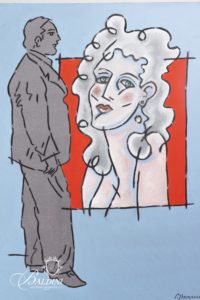 No, not at all. I was in a little show at the Parthenon and Biel was giving a tour with about thirty of his students and a reporter from The Nashville Banner. Biel would go around to each painting and come up with some dramatic and witty criticism of each piece for the sake of the press and to keep his students engaged. He came up to my piece, though, and exclaimed, “Now this man knows how to paint!” Biel’s praise was reported in the banner alongside a picture of him and his students standing with my work. I was in my early twenties and was thrilled to have someone of Biel’s stature commend my work.
No, not at all. I was in a little show at the Parthenon and Biel was giving a tour with about thirty of his students and a reporter from The Nashville Banner. Biel would go around to each painting and come up with some dramatic and witty criticism of each piece for the sake of the press and to keep his students engaged. He came up to my piece, though, and exclaimed, “Now this man knows how to paint!” Biel’s praise was reported in the banner alongside a picture of him and his students standing with my work. I was in my early twenties and was thrilled to have someone of Biel’s stature commend my work.
A friend of mine had seen the article and picture in The Nashville Banner and called me up asking if I wanted to meet Biel-Bienne. My friend had been a student at Vanderbilt and knew the artist, and he told me that Biel-Bienne would like to meet me.
So we went over to Biel’s studio, and it just nearly tore my head off. I feel like I learned more from Eugene Vitalis Biel-Bienne than just about anyone else. Here was a guy standing in front of me who had shared a studio with Picasso. He had all these stories of Juan Gris and Giacometti and Brock…they were like storybook characters to me, but he knew them and would tell me stories of adventures they’d had together. It made the idea of making art like that do-able to me.
You’re more confident in your voice with the validation of someone you admire.
Exactly. When you’re young, you’re trying to figure out an awful lot of things. You’re trying to figure out who you are, and painting is part of that.
In putting together my first book, the works went all the way back to 1961 and the one thing that really pleased me was that I thought the early part of the book could look very schizophrenic—the 1960s and 1970s as opposed to the 1990s and 2000s—but what you see there are the seeds. So I feel like I’ve been following the same trail. It’s migrated, but it’s never gone too far off the path was set back in the 60s.
So you think that, as you’ve gone on, your works have become truer to yourself?
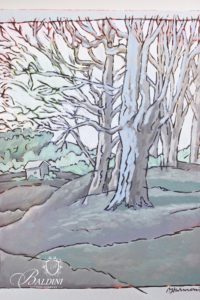 Yes, but make no mistake about it—we’re still standing on the shoulders of the people that came before us. I gave an interview in Austin, TX in the 1980s that I still stand by. I told the interviewer that I imagined myself in a large auditorium with hundreds of painters. I set up my easel and I look to my right, and there’s Matisse with his fabulous colors, and so I use some of that. I look to my left and there’s Giacometti working in greys, so I use some of that. There’s Picasso with his “anything is fair” attitude, so I use some of that. And Raphael, and Vermeer, and so on. I move my easel around the room and use a little bit of those around me, until one day I find myself in the corner, with white walls to my left and right. I’m not seeing other paintings anymore, but they’re all still right there behind me.
Yes, but make no mistake about it—we’re still standing on the shoulders of the people that came before us. I gave an interview in Austin, TX in the 1980s that I still stand by. I told the interviewer that I imagined myself in a large auditorium with hundreds of painters. I set up my easel and I look to my right, and there’s Matisse with his fabulous colors, and so I use some of that. I look to my left and there’s Giacometti working in greys, so I use some of that. There’s Picasso with his “anything is fair” attitude, so I use some of that. And Raphael, and Vermeer, and so on. I move my easel around the room and use a little bit of those around me, until one day I find myself in the corner, with white walls to my left and right. I’m not seeing other paintings anymore, but they’re all still right there behind me.
I love that. Speaking of some of your influences, you mentioned Matisse and his use of color. You’ve been called a master colorist yourself, and your unique use of color has become a characteristic element in your work. How do you go about choosing your color palettes?
I’ve gotten a lot of press about my use of color and it’s a curious thing to me because I don’t think of myself as a colorist. I think of myself as a drawer of line, and once I get a subject to where the lines make sense and express as close as I can to what I’m trying to achieve, then I use color to build contrast. I really just use color to round it out or flatten it or make it more dramatic or more subtle. The color is a tool to the drawing.
Also, I’m a kill painter. What I mean by that is that rather than one very careful line, I’ll make ten lines and kill the nine that don’t work. Sometimes I’ll intellectually think that I need a certain color, only to scrape it down and come back with another. So the canvases are changing all the time.
Also, being a kill painter takes on another aspect in that I don’t want to give too much away in a painting. I’ve painted a number of canvases that I felt like were successful as an image, but I thought, “This looks like a really well-painted illustration for a chapter in a book that nobody else has read but you”. So if you look at a painting like that, you don’t understand it, but if I just remove some elements, then you can look at it and have a definite opinion about what’s going on and how you should feel about it. And that could be a completely different thing from what I was thinking while painting it, but either way, the painting now has legs. It has legs for you, and it has legs for me.
I’ve noticed that when you do edit it down, you maintain a lot of recurring imagery. You use a lot of birds, chairs, fish, rabbits… What is the importance of those particular images to you?
In medieval times, very few people could read, but most people could read paintings. They 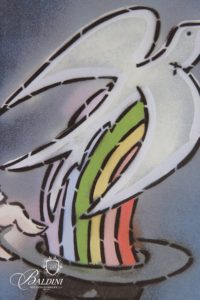 knew that if there’s a well in a painting, it meant something. You mentioned the hare—that’s one of the biggest symbols in art, probably second only to the moon. If you take the rooster, it has a different meaning in Germany than it does in France than it does in Japan. So you could still interpret the painting if you wanted to, and you could interpret it a lot of different ways.
knew that if there’s a well in a painting, it meant something. You mentioned the hare—that’s one of the biggest symbols in art, probably second only to the moon. If you take the rooster, it has a different meaning in Germany than it does in France than it does in Japan. So you could still interpret the painting if you wanted to, and you could interpret it a lot of different ways.
There are people that are successful and do very well painting old barns and cattle and such. I’ve never been interested in that. I want to paint an idea. I guess the idea I’m trying to paint in all my paintings, from my point of view, this is what it’s like to be a human on this planet. You remarked earlier that I’m still painting full-steam. You just don’t get through painting that sort of concept.
And I think that’s apparent in your work, too—that you’re not painting objects; you’re painting concepts. Your stenciled lines, which are another trademark of your work—Are they meant to emphasize that difference between the Object and the Concept?
They were stenciled lines up until about ten years ago, and then I just started doing the line work with a brush. I think it appeals to me because, let’s say I paint a picture of a woman, and she’s posed like a portrait. I think with the stencil line, it doesn’t necessarily say, “This is Mary So-and-so”. It says “This is woman”. She’s a symbol for a woman.
In the 60s I went down to New Orleans and went through some of those mile-long warehouses where crates of materials were being transported all over the globe, and I was struck by the packing crates. They’d have a champagne glass on them, or an umbrella, or a hand pointing upward, and they’re all stenciled. And I came back from New Orleans and started trying different things, and none of them worked until I cut a stencil and stuck it on the wet paint and thought, “Ah, that works!” Then, over the next couple years, stenciling took up pretty much all of the line work of the painting. And so that became a symbol instead of a thing. It’s a rabbit, but there’s a stencil in the design of the rabbit, so it’s a symbol.
There’s one more element that’s signature to your work that I want to ask you about, and that’s your use of juxtaposition. Is the juxtaposition purely aesthetic to you or is it something more symbolic to help encompass what you’re trying to relay about the human experience?
I’ve wondered about that, too, and I haven’t really come up with a good logic for it. The reason for multiple things in there, though—and I’m speculating somewhat—is that I think of it like a sentence diagram. Imagine a diagram of a sentence up on the blackboard. You have the noun and the verb and the adjective and the adverbs coming off of that diagram. I think that one image in a painting is the noun and the other is the adjective, and so on. Then I look at it again and think, “Well no, this is the noun…” So I like to think that it gives the painting longer legs. Every time you see it, it could be a little different.
It’s also really a gut feeling that these different objects somehow connect, but I don’t think it’s important for the viewer to know what the connection is. They can come up with their own. Sometimes I’ll have a good reason for it. I did a portrait of James Joyce and I put his likeness next to a couple kissing next to a very large dimensional red cross. Well, the Joyce Park in Vienna is right across the street from the Red Cross Hospital, and the cafeteria there is named after two of the characters from Ulysses.
So they’re all tied together in your mind, and you’re putting your personal connections down onto the canvas?
That’s right. I’ve got a great job. It’s not like a lot of jobs where you do it, and then you take leisure—where you work, and then you’re with your family, or you work and then you’re with your friends. I’ve pretty successfully been able to break it down to where it’s relatively seamless—my personal life, my private life, painting… it’s all kind of the same thing. That’s been tough to do, because one thing can be a distraction from the other. Something can distract you from painting, but if you embrace it with the painting then it becomes useful. There may be something bad that happens in your life, and the instinct is to shy away from that, but if you’re a creative person, you don’t want to deny that. You go in and embrace it and live with it and just devour it and cover yourself with it. It’s usable. You’ve defeated it by transforming it and using it in a productive way. And then it’s not so bad.
So you run your life alongside your art. And you’ve chosen to base both of those things out of Nashville. After maintaining a studio in Paris and achieving international acclaim,
what made you stay here?
Well, maybe things could have been more commercially productive if I had gone to New York or one of the other major centers of art, but I always felt like I knew a bunch of other painters who went to New York, became successful, and then moved to Captiva Island or upstate New York or out to the desert someplace. I just thought I would like to skip that step. I’m really happy here.
In this auction, you have some original ceramics, wood cutouts, and prints as well as canvases. When did you start working in those mediums and what appeals to you about those over canvases?
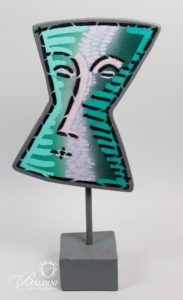 If I were dropped on a desert island and they said I only have one medium I could work in for the rest of my life, I’d say “OK, give me oils and canvas”. I find, though, that it’s really healthy as an artist to stop painting in oils for a bit and do watercolors, then t stop doing watercolors and do prints.
If I were dropped on a desert island and they said I only have one medium I could work in for the rest of my life, I’d say “OK, give me oils and canvas”. I find, though, that it’s really healthy as an artist to stop painting in oils for a bit and do watercolors, then t stop doing watercolors and do prints.
I think the cutouts or the ceramics ties in with the idea that you do something very different and then you come back to the canvases fresher. You go from the canvases to watercolor or ceramics and although the mediums are very different, you learn something that could be used for the other. I just feel like working in ceramics or cutouts or anything like that brings you back fresher to the other mediums.
Treating this auction as a gallery exhibit spanning four decades of your career, do you think people can glean a stylistic trajectory of your artistry as a whole?
I feel that there’s a thread that runs through it. A French reviewer once gave me one of my best reviews ever. He said something to the effect of, “He paints a number of different kinds of images in a lot of different mediums, but from a distance of a hundred meters from a car moving sixty kilometers per hour, you can spot his work”. And I think that people can with the body of work that is in this auction.
While selecting the work for this auction, we wanted to have a variety—some lithographs, some serigraphs, some etchings, some watercolors, and some paintings from difference decades, too. But as my wife and I went through everything, I can’t tell you how many times we said, “Oh, I hate to see this one go”. Because I love my work. I love what I do. These are not stray puppies; these are works that I have loved and enjoyed, but they don’t really live until they go out into the world.
INTERVIEW BY JOSHUA DANIEL FISHER

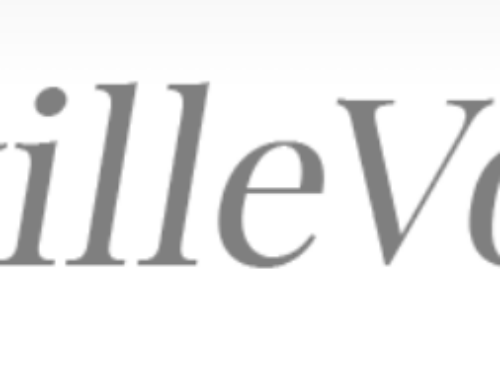
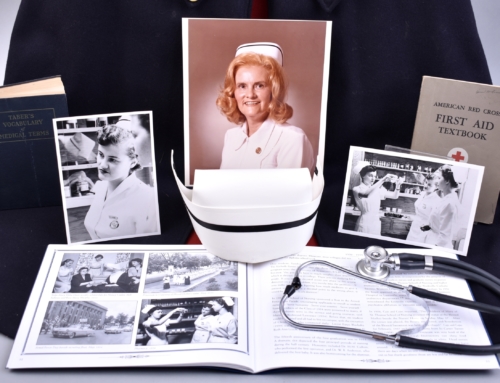

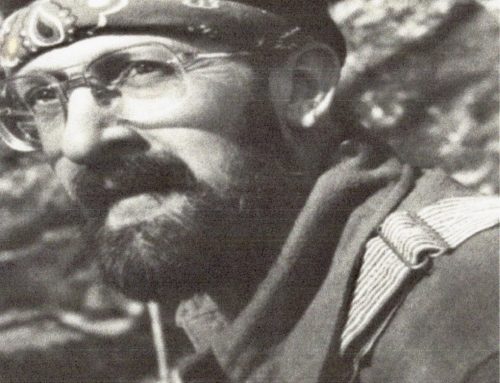
Leave A Comment